Tosca
Tosca by Giacomo Puccini is a dramatic opera set in 1800, in June of that year to be exact, and it plays out in Rome. It has a distinct political intrigue following the famous singer Tosca who is forced to make a terrible sacrifice to save her lover, Cavaradossi from the ruthles chief of police, Scarpia.
Don’t be afraid though. The music is still Puccin’s and as such, some of the most beautiful that has ever been written for the stage. The story is very up-to-date, the plot is easy to understand for a beginner, and the Verismo elements are in no way more frightening than an average news broadcast.
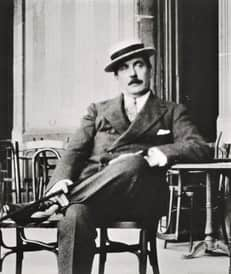
Premiere 26 Settembre 1835. Teatro Costanzi (Rome Operahouse), Rome, Italy.
Composer – Giacomo Puccini
Librettist – Giuseppe Giacosa, Luigi Illica
Running Time – 2 hours or less, plus Intervals
Three Acts
Act 1 – 45 minutes
Act 2 – 43 minutes
Act 3 – 27 minutes
In Italian
Main characters
- Floria Tosca – Lyric-Dramatic soprano. Famous singer. Very much in love with Mario.
- Mario Cavaradossi – Lyric-Dramatic tenor. Painter. Republican and revolutionary follower of Napoleon.
- Scarpia – Dramatic Baritone. Chief of Police. Wicked, depraved, and ambitious.
————————–
- Spoletta – Tenor. Scarpia’s handyman.
- Angelotti – Bass. Imprisoned politician who’s managed to flee.
- Sacristan – Bass
- Sciarrone – Bass. A Gendarme in Scarpia’s Police.
- Shepheard-boy – Child-soprano
Based on the screenplay La Tosca by Victorien Sardou.
Download this short Pdf-guide. Print it, fold it, and keep it in your pocket as a help when you’re at the Opera. Please keep your phone turned off when inside the theater.
Background – The Opera Tosca is set in…
Rome
The time is actually very precise. It’s tuesday June 17, 1800. We know this because there are two significant breaking news in the drama. In the first act the Sacristan tells his altar boys that Napoleon has been defeated by the Austrians at the Battle of Marengo. This is not true, but it makes everybody very happy, and they dance and shout and sing.

In the second act there’s the correction of the report. The Austrians didn’t win, but Napoleon did. This makes Cavaradossi cry out in a triumphant: Victory! That outburst makes a big difference and it takes the story on a very different and much more sinister path.
But let’s not jump ahead.
The historical background…
In 1800 the French and Napoleon entered Italy in their second Italian Campaign. The Austrians under commander Michael von Melas, defended their territories in northern Italy. Hard times, but fighting was nothing new for the Italians. 1700, as well as 1800, was an extremely turbulent time in Italy… (As were most of the centuries before that.) Practically all of Europe had troops in the Italian boot and many of the old City-states still had reasonably strong armed forces. To this came the new revolutionary ideas from France about brotherhood, freedom, and equality, that inspired resistance against the old Noble class, their Kings, and their Emperors.
So, the French-Austrian-Neapolitan/Sicilian conflict was in no way the only war going on. If it’s difficult to grasp the overall political situation, at least one or two things could be useful to keep in mind.
- The First Roman Republic (1798-1799), as well as the Republic of Naples (1799), were formed after Napoleon’s first campaign in Italy. These were closely connected to the ideals of the French revolution and the French.
- In 1799 King Ferdinand, of the house Borbone, with the help of both the English and the Austrians, reconquered both Naples and Rome as the French left.
- In 1800 the French came southward again to defeat the Royalists. At this time there were politically motivated persecutions in Rome. The republicans were arrested, tortured, and imprisoned, and Scarpia in the Opera is the head-butcher. An evil man with limitless power.
Plot
There’s no Ouverture. We jump right into the drama…
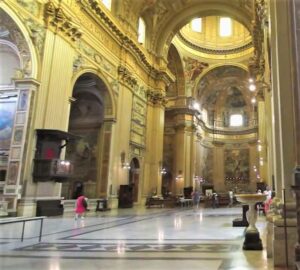
Act 1 – Basilica di Sant’Andrea della Valle, Rome.
The orchestra plays a Bb major that moves to an E major, fortissimo, very strong. These harmonies are harmonically as far away from each other as you can get. It creates an incredibly dramatic opening.
A man staggers through the church. He’s searching for something. He finds a key, and when he hears steps, he hides inside one of the chapels.
The Sacristan enters, and after a while, Mario Cavaradossi, the painter. We get to know that Cavaradossi is working on the altarpiece of the Virgin Mary. He’s painting her a bit too seductive. In fact, it’s a portrait of Marchioness Attavanti, who he’s seen when she comes to the church to pray.
He sings Recondita Armonia (Obscure harmonies). He practically says that the beauty of the two women, Giulia Attavanti and his own beloved Floria Tosca, is different but they are both admirable. His heart is completely in Tosca’s hands though.
This is a feared aria for the tenor. Not because it’s difficult, but because it comes after you’ve sung only 15 bars, and been on stage for a little more than one minute.
——————-
The Sacristan leaves, and Cavaradossi hears someone hiding in the Attavanti-chapel. Cesare Angelotti, the name of the person hiding in the church, is a fugitive from the dreaded Castell Sant’Angelo… A prison, garrison, and execution site. He was the Governor of the short-lived Roman Republic. Cavaradossi is loyal to the republic and offers to help him. Now Tosca is calling outside the door. Angelotti hides again.
The Primadonna.
Tosca is a jealous woman and she’s suspicious about the door being locked. She has a concert that same evening, but she tells him that they can meet afterward. She sings Non la sospiri la nostra casetta (Don’t you long to meet at our house…).
Puccini paints the situation very clearly… Cavaradossi loves Tosca, but he has to get her outa there to be able to help Angelotti. And he can’t tell her about it because she’s devoted to Art, Music, and Christianity, and she’s not very politically interested. Tosca senses that something’s off, but she lets him assure her.
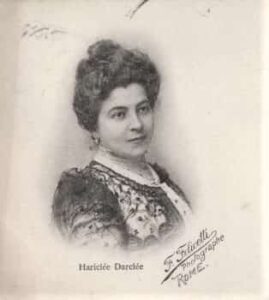
When she’s about to go, she discovered, the portrait of Attavanti, and the jealousy ignite again. Together they sing the beautiful love-duet. Qual’occhio al mondo può star di paro (In all of the world there are no eyes like yours…).
When she’s gone Angelotti comes forward again. The two companions make plans and. Cavadarossi sends him to his Villa through the back door.
Here’s a high B for the tenor. It’s not an extreme note, but it’s the highest in Tosca, and for a spinto-tenor, it could be on the high side. You hear the same Bb major and E major as at the beginning, and then he sings “La vita mi costasse… “. It’s completely without accompaniment, the orchestra is silent. It’s scary.
Then the cannon at Castell Sant’Angelo fires, to signal the escape, and the going gets rougher. They both run out the backdoor.
There’s actually a cannon-shot. Nowadays we have digital cannons, but in the old times you had to use mechanical machines. And they could be just as good, sometimes even better.
The Sacristan, the altar-boys (children), a few priests have all heard the (incorrect) news that the Austrians won at Marengo. That would mean Napoleon’s defeat, and that Naples, and the Pope would still be in power. They dance around and cheer…
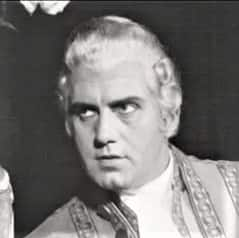
The really, really bad guy.
The now famous Bb to E major is played again. And Scarpia makes his entrance in church and in the story. He’s a demon. He takes away the joy and happiness like a light switch turns on darkness. Everybody is scared to the bones.
He immediately gets the picture.
- He finds Giulia Attavanti’s hand fan, and he notices her portrait as the Madonna.
- The Attavanti-chapel is open.
- The food, the Sacristan had provided for Cavaradossi, is all gone. As is the painter.
Scarpia keeps the hand fan, because he already has his devilish plan elaborated.
Soon after Tosca arrives, and when she can’t find her lover, jealousy immediately boils in her veins. All Scarpia has to do is to gently feed it with comments and explanations. He shows her the hand fan, and the bait is set.
When Tosca says:
– Tu non l’avrai stassera. Giuro! (You shall not have her tonight… I swear it!)
Scarpia answers with pretended religious faith:
– In church…
Tosca answers with great emotion and dramatic expression.
– God will forgive me, when he sees my sorrow…
And the love-theme from the first part is heard in the orchestra, as Scarpia comforts her and helps her out.
He then tells Spotella to follow her.
The last part is fabulous. The church bells ring, and the full chorus enters in procession for the Te Deum, the Mass. In the middle Scarpia stands like the dark forces in person. Because his goal is not only Angelotti’s head… But he want the Primadonna as well.

Act 2 – The Farnese palace, Rome.
This is one of the best, and most terrifying 45 minutes ever written for the stage.
Palazzo Farnese was the Palace for the King of Naples in Rome. So, the King, Ferdinand IV (… or Ferdinand III, or I, depending on which title you refer to, Yes, a bit of a confusion here.) of Naples with all his guests are celebrating the victory at Marengo. Scarpia is dining in a nearby room.
Scarpia is enjoying his dinner, in perfect control. He tells Sciarrone to bring Tosca to him as soon as she’s finished with the concert for the King that is held on the Noble floor. You hear the music through the open windows.
Now Scarpia sings his climax, the Aria: Ha più forte sapore la conquista violenta che il mellifluo consenso. (The violent conquest tastes better than the honey-sweet consent.)
The title more or less says it all.
Spoletta enters and reports that they followed Tosca to the Villa. There they couldn’t find Angelotti. but they arrested Cavaradossi. He is lead in to Scarpia.
The indisputable power of Scarpia is flanked by the Judge, the Police, the Torturer, and the Executioner. The dictatorship in plain sight. In the background, you hear the choir and the voice of Tosca, from the open window.
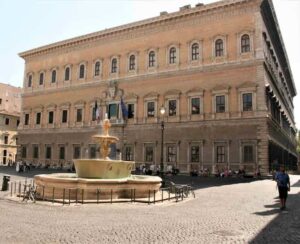
Tosca enters, and she’s told by Cavaradossi to keep her mouth shut, before he’s taken away for “interrogation”.
Here follows one of the most terrifying and ghastly scenes ever in the Opera literature. Scarpia is talking educatedly with Tosca, while Cavaradossi is in the next room. As the conversation progresses, and Tosca doesn’t give the right answers, the screams from the painter being tortured are heard. And Tosca’s resistance crumbles and leaves her without defenses to the attacks of the Chief of Police. When Cavaradossi cries out for the last time, she can’t take it anymore…
– In the well, she says. That’s where Angelotti is.
Tosca’s unbearable choices.
The prisoner is brought to her, and a lot happens quickly here, so stay concentrated.
- Tosca says that she hasn’t said anything.
- Scarpia triumphantly shouts: “… In the well”, and tells Spoletta to go get Angelotti.
- Cavaradossi curses his lover for being a traitor.
- Sciarrone enters and gives the news, that in fact Napoleon has won at Marengo, and the Austrians have fled.
So, Cavaradossi stands up and sings:
– Vittoria!… Vittoria! (Victory!)
Then he continues throwing accuses against Scarpia, which sends him right back in prison and signs his death sentence.
Now, Tosca will have to negotiate for his life a second time. Only this time, she has to pay with other merchandise. There are two arias. First a short but very dramatic and powerful outburst by Scarpia
– Già! mi dicon venal (They say I’m corrupt… )
When the diva understands the trade, she says that she’ll throw herself out the window. But Scarpia answers that there’s no need for that. She is free to leave anytime she wants…
And the deal becomes obvious. She will have to give herself to Scarpia to save Cavaradossi.
The Aria Vissi D’arte is nothing less than a miracle of beauty, and a confession suitable for any artist of any genre… And to think that it almost didn’t make it to the final score.
I lived for art, I lived for love,
I never harmed a living soul!
With a discreet hand
I relieved all misfortunes I encountered…
I donated jewels to the Madonna’s mantle,
and offered songs to the stars and to heaven…
why, why, Lord,
ah, why do you reward me like this?
The Conclusion
Spoletta arrives with more news. Angelotti was dead at their arrival. He had taken his own life. At Scarpia’s question Tosca nods almost inviìsible. So, Scarpia says that he can not free him just like that. They will have to carry out a fake execution.
Tosca demands a pass for her and Cavaradossi to leave the country forever. Scarpia grants it.
The truth is that they are both playing dishonestly. Scarpia tells Spoletta that the execution shall be simulated, as they did with Count Palmieri…
– Do you understand? Like Palmieri?
This is a code for a real execution. He’s not going to save him.
Tosca grabs a knife from the table, and when Scarpia approaches her with a triumphant:
– Tosca… Finally, you are mine…
She stabs him. And when he’s lying on the floor suffocated in his own blood, she speaks:
– In front of him, all of Rome trembled.
She grabs the pass from his pocket, put two candlesticks besides the body, and runs for Castel Sant’Angelo.
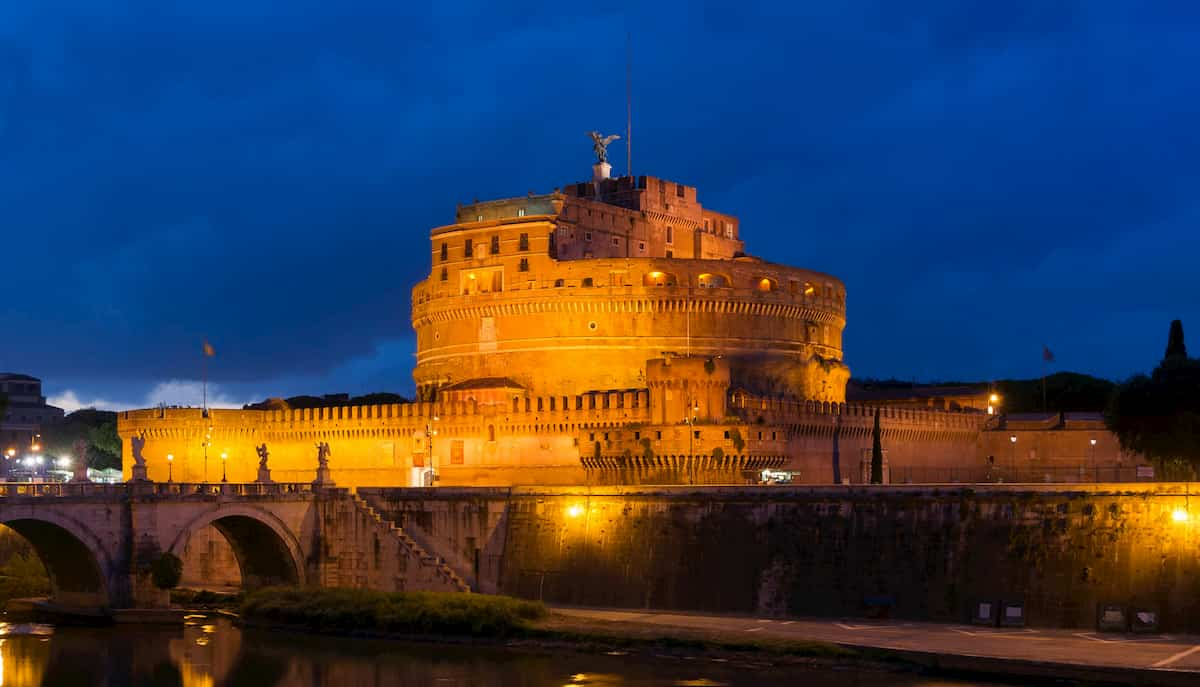
Third act – Dawn. Castell Sant’Angelo.
The act opens up with a wonderful song by a young shepherd-boy. This is sometimes sung by an adult soprano, but that is completely wrong. It must be a child.
Mario Cavaradossi is waiting to be executed. He sings another of the fabulously beautiful Arias from this masterpiece:
– E lucevan le stelle… (And the stars were shining… And footsteps… Twas hers, the fragrant creature… .I die in despair… Never was life so dear to me!)
Tosca comes rushing in. They embrace each other as she tells him what’s happened. And there’s another fabulous duet: O dolci baci e languide carezze followed by Amaro sol per te m’era il morire. They are not distinct duets, but just parts of a long scene where Floria and Mario are immensely happy to survive, and to be able to leave this forsaken place together. Tosca tells him about the execution… That he has to pretend to die to not cause any alarm.
Some interpreters suggest that Cavaradossi at this point understands that he’s going to die, but that he doesn’t want Tosca to know. And that he’s still so very greatful to be able to say farewell to her. Puccini doesn’t reveal anything.
Now, the guards come to take him away. Tosca reminds him to fall at first shot. They put him to the wall, aim and fire.
Tosca watches from a distance. She’s proud of the actor-skills he demonstrates. When they’re all gone she comes forward…
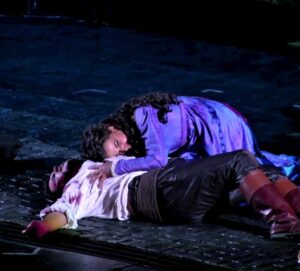
Things to look out for
First Act
- 6 minutes Recondita armonia, Cavaradossi’s first Aria
- 19 minutes Qual’occhio al mondo… Tosca and Cavardossi, duet.
- 24 minutes Angelotti comes out again. After a minute there’s the high B by Cavaradossi. Check it out.
- 28 minutes They escape, the Sacristan enters, and there’s cheering and dancing…
- 30 minutes Scarpia makes his first appearance.
- 41 minutes When you hear the church bells, and the organ, that’s the beginning of the last part. Culminating in Te Deum
Second Act
This is one of those moments where you just have to stay tuned. There’s a lot to take in.
- 3 minutes Ha più forte sapore… Scarpia’s Aria
- 9 minutes Tosca enters, Cavaradossi is able to warn her before being taken away.
- 18 minutes Tosca asks Mario if he allows her to speak. He answers: No. There’s a slow movement in D minor. Spoletta mumbles a prayer in Latin. When Mario screams Tosca reveals the hiding place.
- 20 minutes Sciarrone reveals that Napoleon won at Marengo. Cavaradossi sings Vittoria Vittoria!
- 28 minutes Vissi D’Arte Tosca’s big Aria
- 34 minutes Spoletta enters. Scarpia says E bene? In the silence that follows Tosca gives her approval with a nod.
- 38 minutes Tosca stabs Scarpia
Third Act
- 0 minutes Io de’ sospiri… A shepherd-boy sings in the distance in Roman dialect.
- 10 minutes E lucevan le stelle… Cavaradossi’s Aria
- 13 minutes Immediately after, Tosca enters.
About the Opera
Tosca is often labeled as a veristic opera, from the Italian literary- and musical genre Verismo. The movement comes from the Italian word vero, real, and is every aspect comparable to realism, with writers such as Honoré de Balzac, Alexander Pushkin, Charles Dickens , and maybe even Emile Zola. The idea was to describe the reality as it is with all its flaws and ugglines.
Verismo, the musical movement in Italy started out with works such as Cavalleria Rusticana by Pietro Mascagni, Pagliacci by Ruggero Leoncavallo, and Andrea Chènier by Umberto Giordano. Although Puccini is not always classified as a Verista, Tosca is always thought of as such.
And it definitely has all the attributes. The second act is an almost naturalistic description of all the horrors that state-oppression can set up. To me, Tosca isn’t more or less Veristic than Puccini’s other Operas. The Maestro was a composer for the theater, and he knew exactly how to tell a story on the Operatic stage. Every note, and every phrase has a theatrical meaning. From the stuttering Sacristan to the screams when Cavaradossi is tortured. Tosca is a different story than Madame Butterfly, or La Bohème, but it’s told with the same expertise, and the same colors. Maybe Puccini is a Veristic composer, maybe he’s not. But Tosca is no different from his other Operas in that sense.
Fun facts
- Puccini was a thorough composer. He went to Rome to measure the frequency of the Bells at Saint Peters Basilica. Then he composed the music at the end of the first Act in the exact pitch. For the bells in the opening of the third act, he measured the morning bells of Castel Sant’Angelo. He then had four different foundries reproduce the bells to the exact pitch.
- The premiere was set in Rome because the story is set there. There were riots and unrest at the day of the opening, so the premiere had to be postponed till the day after, January 14, 1900. Due to warnings of an anarchist bombing, the conductor was supposed to strike up the royal march, a patriotic, national anthem if there were to be problems.
- Tosca is the only one of Puccini’s Operas that didn’t premiere in the north of Italy, or at Metropolitan, New York.
- Puccini, as usual, was arguing quite a bit with his librettists, Giuseppe Giacosa and Luigi Illica. After the premiere, Illica said that the final libretto was shadow of its original form due to impossible demands put forward by the composer. He had suggested an alternative ending, were Tosca doesn’t die, but goes crazy. Nor Puccini neither Sardou agreed to it… Fortunately.
- Tosca’s big Aria in the second act, Vissi D’Arte, is one of the most famous and spectacular Opera Arias ever. But it was almost cut out. Puccini didn’t want it there, as it interrupts the flow of the story-line. Correct, Maestro, but what a loss it would have been…
- The last roles that one of the greatest sopranos of all times played, was Tosca. I’m of course talking about Maria Callas. She did a sort of come back in the role in 1964 (Of which fortunately, there is a video recording of the second act). On July 5, 1965 the Diva sang her last Tosca at Covent garden, London. This was at the very end of her destructive relationship with Aristotle Onassis
Download this short Pdf-guide. Print it, fold it, and keep it in your pocket as a help when you’re at the Opera. Please keep your phone turned off when inside the theater.